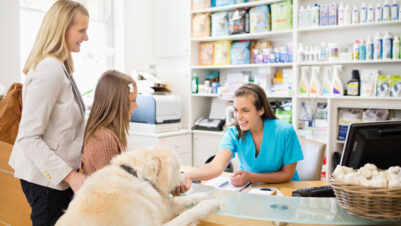
A lot has changed in the 16 years that I’ve been a veterinary receptionist.
When I first started, I did not have any kind of interview; it was, literally, a quick chat with the head receptionist, where I expressed that I would love to join the reception team. Within a week, I had another quick chat with one of the owners and started in days!
Training was on the job, and you had to roll up your sleeves and muck in. There was no written welcome pack with hints or tips; it was either do it right or ask for help – something that would be unacceptable now.
The development of reception staff wanting to learn and grow within their role has led to more respect being given by colleagues and clients
Receptionists were valued but overlooked and weren’t really given any credit or support in the role. The development of reception staff wanting to learn and grow within their role has led to more respect being given by colleagues and clients.
Looking back
My practice was initially a private clinic with two primary proprietors and four veterinarians covering all the practice’s needs and after-hours shifts. The whole practice was very friendly and compassionate, and the clients and patients saw the same vet they had built a rapport with. Clients could call on the day for an appointment and be seen with ease. Often clients would turn up for repeat medication and have it either there and then or by the next day at the latest.
Nothing was ever a problem, and it was much easier to fulfil a client’s needs, especially if it was stock related as we had deliveries every day and not twice a week like now! All the medication orders were entered into a book (yes, a book!), and checked and signed by the vet once reception had booked and put them out.
It was uncomplicated and gentle, with lots of time to be client-facing and get to know each client well, and over time we became like an extended family
When it came to payments, our clients had an account with us and, thus, paid by invoice. It was a much more relaxed approach, and we never had any cross clients when we asked for payments. There were no questions about costs or pricing, no contesting the vet’s expertise and no comparison shopping like there is now.
It was uncomplicated and gentle, with lots of time to be client-facing and get to know each client well, and over time we became like an extended family.
However, there was no formal training for veterinary receptionists back then, and practices were far less busy or stretched than they are now.
Current state of affairs
The role at my practice now is quite different to how it was then. This is due, in part, to our practice being part of a corporate and the growth in the practice. These changes have brought many benefits but also drawbacks.
Whereas the receptionist’s main role was previously to welcome clients and schedule appointments, there is now so much more paperwork to complete with health clubs and discounts, online bookings and telephone ordering, written prescriptions and scanning client data. We still put in a lot of effort to keep a welcoming environment for clients and staff but this can be challenging during busy periods. There are also more benefits for clients, such as text services for boosters, appointments and medication collections, which allows for speedier interactions and less time spent on the phone.
Many practices use a rota system for their receptionists, so each employee is in charge of a specific responsibility each day in addition to their principal reception duties. Others rotate personnel so they spend every other day working on other jobs in the practice rather than on reception, which, in my opinion, is better for the reception staff. This is because they get more valuable time with clients and patients, building relations and strengthening the bond with the practice.
We currently use the rota system in my practice, so each staff member must complete set tasks each day on top of reception duties. We also ask clients to request flea and worming treatments or drugs at least 72 hours in advance and make sure to schedule our vaccinations and routine visits at least six months in advance.
We’ve had to make changes to control nurse and vet diary appointments so they don’t get booked up with too many non-emergency appointments in a day. The lack of available appointments is, in part, due to the global vet shortage (which is having a severe effect on practices), the increase in pets since the COVID-19 lockdowns and the construction of new homes nearby, meaning we frequently run out of appointments!
For receptionists to survive these changes and demands, we need to be given proper training and be valued in our role
Many veterinary professionals are currently experiencing extreme stress, but those in rural or coastal locations are severely affected. Clients’ expectations of what they require from their veterinary practice has changed, including reasonable costs, online assistance, round-the-clock accessibility and appointments being available exactly when they need one. At times, this makes the job very stressful and has resulted in a significant turnover rate in reception staff.
For receptionists to survive these changes and demands, we need to be given proper training and be valued in our role. Things are improving, and I’m glad we now have a recognised association for receptionists. It has taken a long time for this to happen, especially as, formerly, only nurses and veterinarians had access to CPD, events and congresses.
Looking back, looking forward
Veterinary receptionists are beginning to gain recognition for the crucial role we play in veterinary practice.
When I first began, I could never have imagined sitting here writing this or getting the chance to be on the British Veterinary Receptionist Association Council. All things considered, after 16 years of practice, this is still the best and most fulfilling profession I’
ve ever had, and I cherish every second of it.
With BVRA supporting us through the highs and lows of our amazing career, I am optimistic about the future role of the veterinary receptionist.











